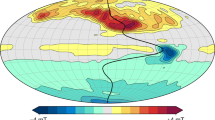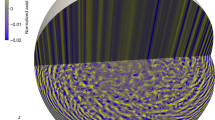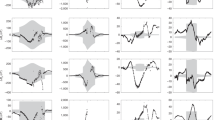Abstract
The discovery of Uranus' and Neptune's non-dipolar, non-axisymmetric magnetic fields1,2,3,4 destroyed the picture—established by Earth, Jupiter and Saturn5,6—that planetary magnetic fields are dominated by axial dipoles. Although various explanations for these unusual fields have been proposed3,7,8,9,10, the cause of such field morphologies remains unexplained. Planetary magnetic fields are generated by complex fluid motions in electrically conducting regions of the planets (a process known as dynamo action), and so are intimately linked to the structure and evolution of planetary interiors. Determining why Uranus and Neptune have different field morphologies is not only critical for studying the interiors of these planets, but also essential for understanding the dynamics of magnetic-field generation in all planets. Here we present three-dimensional numerical dynamo simulations that model the dynamo source region as a convecting thin shell surrounding a stably stratified fluid interior. We show that this convective-region geometry produces magnetic fields similar in morphology to those of Uranus and Neptune. The fields are non-dipolar and non-axisymmetric, and result from a combination of the stable fluid's response to electromagnetic stress and the small length scales imposed by the thin shell.
This is a preview of subscription content, access via your institution
Access options
Subscribe to this journal
Receive 51 print issues and online access
$199.00 per year
only $3.90 per issue
Buy this article
- Purchase on Springer Link
- Instant access to full article PDF
Prices may be subject to local taxes which are calculated during checkout



Similar content being viewed by others
References
Ness, N. F. et al. Magnetic fields at Uranus. Science 233, 85–89 (1986)
Ness, N. F. et al. Magnetic fields at Neptune. Science 246, 1473–1478 (1989)
Connerney, J. E. P., Acuna, M. H. & Ness, N. F. The magnetic field of Uranus. J. Geophys. Res. 92, 15329–15336 (1987)
Connerney, J. E. P., Acuna, M. H. & Ness, N. F. The magnetic field of Neptune. J. Geophys. Res. 96, 19023–19042 (1991)
Connerney, J. E. P. Magnetic fields of the outer planets. J. Geophys. Res. 98, 18659–18679 (1993)
Russell, C. T. Magnetic fields of the terrestrial planets. J. Geophys. Res. 98, 18681–18695 (1993)
Ruzmaikin, A. A. & Starchenko, S. V. On the origin of Uranus and Neptune magnetic fields. Icarus 93, 82–87 (1991)
Podolak, M., Hubbard, W. B. & Stevenson, D. J. in Uranus (eds Bergstralh, J. T., Miner, E. D. & Matthews, M. S.) 29–61 (Univ. Arizona Press, Tucson, 1991)
Hubbard, W. B., Podolak, M. & Stevenson, D. J. in Neptune and Triton (ed. Cruikshank, D. P.) 109–138 (Univ. Arizona Press, Tucson, 1995)
Holme, R. Three-dimensional kinematic dynamos with equatorial symmetry: application to the magnetic fields of Uranus and Neptune. Phys. Earth Planet. Inter. 102, 105–122 (1997)
Hubbard, W. B. et al. Interior structure of Neptune—comparison with Uranus. Science 253, 648–651 (1991)
Nellis, W. J. et al. The nature of the interior of Uranus based on studies of planetary ices at high dynamic pressure. Science 240, 779–781 (1988)
Kuang, W. & Bloxham, J. An earth-like numerical dynamo model. Nature 389, 371–374 (1997)
Kuang, W. J. & Bloxham, J. Numerical modelling of magnetohydrodynamic convection in a rapidly rotating spherical shell: weak and strong field dynamo action. J. Comput. Phys. 153, 51–81 (1999)
Glatzmaier, G. A. & Roberts, P. H. A 3-dimensional convective dynamo solution with rotating and finitely conducting inner core and mantle. Phys. Earth Planet. Inter. 91, 63–75 (1995)
Glatzmaier, G. A. & Roberts, P. H. A 3-dimensional self-consistent computer simulation of a geomagnetic field reversal. Nature 377, 203–209 (1995)
Dormy, E., Valet, J. P. & Courtillot, V. Numerical models of the geodynamo and observational constraints. Geochem. Geophys. Geosyst. 1, 2000GC000062 (2000)
Grote, E., Busse, F. H. & Tilgner, A. Regular and chaotic spherical dynamos. Phys. Earth Planet. Inter. 117, 259–272 (2000)
Grote, E. & Busse, F. H. Hemispherical dynamos generated by convection in rotating spherical shells. Phys. Rev. E 62, 4457–4460 (2000)
Kutzner, C. & Christensen, U. R. From stable dipolar towards reversing numerical dynamos. Phys. Earth Planet. Inter. 131, 29–45 (2002)
Ishihara, N. & Kida, S. Equatorial magnetic dipole field intensification by convection vortices in a rotating spherical shell. Fluid Dyn. Res. 31, 253–274 (2002)
Aubert, J. & Wicht, J. Axial versus equatorial dipolar dynamo models with implications for planetary magnetic fields. Earth Planet. Sci. Lett. (in the press)
Roberts, P. H. & Glatzmaier, G. A. The geodynamo, past, present and future. Geophys. Astrophys. Fluid Dynam. 94, 47–84 (2001)
Hollerbach, R. & Jones, C. A. Influence of the Earth's inner core on geomagnetic fluctuations and reversals. Nature 365, 541–543 (1993)
Wicht, J. Inner core conductivity in numerical dynamo simulations. Phys. Earth Planet. Inter. 132, 281–302 (2002)
Marley, M., Gomez, P. & Podolak, M. Monte Carlo interior models for Uranus and Neptune. J. Geophys. Res. 100, 23349–23353 (1995)
Zhang, K. K. & Schubert, G. Teleconvection: remotely driven thermal convection in rotating stratified spherical layers. Science 290, 1944–1947 (2000)
Jones, C. A., Longbottom, A. W. & Hollerbach, R. A self-consistent convection driven geodynamo model, using a mean field approximation. Phys. Earth Planet. Inter. 92, 119–141 (1995)
Merrill, R. T., McElhinny, M. W. & McFadden, P. L. The Magnetic Field of the Earth 31 (Academic, San Diego, 1996)
Holme, R. & Bloxham, J. The magnetic fields of Uranus and Neptune: methods and models. J. Geophys. Res. 101, 2177–2200 (1996)
Acknowledgements
We thank D. Stevenson for comments on the manuscript. This work was supported by NSERC and NSF.
Author information
Authors and Affiliations
Corresponding author
Ethics declarations
Competing interests
The authors declare that they have no competing financial interests.
Rights and permissions
About this article
Cite this article
Stanley, S., Bloxham, J. Convective-region geometry as the cause of Uranus' and Neptune's unusual magnetic fields. Nature 428, 151–153 (2004). https://doi.org/10.1038/nature02376
Received:
Accepted:
Issue Date:
DOI: https://doi.org/10.1038/nature02376
This article is cited by
-
Diamond precipitation dynamics from hydrocarbons at icy planet interior conditions
Nature Astronomy (2024)
-
Melting curve of superionic ammonia at planetary interior conditions
Nature Physics (2023)
-
Ammonia and the ice giants
Nature Physics (2023)
-
Double superionicity in icy compounds at planetary interior conditions
Nature Communications (2023)
-
Dynamic compression of water to conditions in ice giant interiors
Scientific Reports (2022)
Comments
By submitting a comment you agree to abide by our Terms and Community Guidelines. If you find something abusive or that does not comply with our terms or guidelines please flag it as inappropriate.



